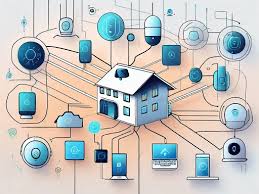Smart Home Integration: How AI is Making Our Lives Easier
The concept of smart homes has transitioned from science fiction to reality in just a few short years. With rapid advancements in artificial intelligence (AI), homes are becoming more interconnected, responsive, and user-friendly. AI plays a pivotal role in enhancing the convenience, safety, and efficiency of smart homes. This article explores how AI is revolutionizing smart home integration and making our lives easier, highlighting key technologies, applications, and the benefits of a smarter living environment.
1. What Is a Smart Home?
A smart home refers to a living space that utilizes internet-connected devices to remotely manage and automate various household systems and functions, such as lighting, security, temperature control, and entertainment. These devices often communicate with one another via a central platform, creating an integrated ecosystem where users can control aspects of their home through apps, voice commands, or AI-driven automation.
AI enables these smart devices to learn from user preferences, predict behaviors, and operate autonomously, reducing the need for manual intervention and creating a more intuitive living environment.
2. AI-Powered Voice Assistants: The Heart of the Smart Home
At the core of most smart home ecosystems are AI-powered voice assistants such as Amazon Alexa, Google Assistant, and Apple’s Siri. These virtual assistants have transformed the way we interact with technology in our homes.
a. Convenience and Control
Voice assistants allow users to control smart devices using simple voice commands, whether it’s turning on lights, adjusting the thermostat, or playing music. This hands-free control adds immense convenience, especially when multitasking or during daily routines.
b. Personalization
AI enables these voice assistants to learn from individual user behavior. Over time, they can recognize user preferences and customize their responses. For instance, if you often ask for the weather in the morning, your assistant may start providing this information proactively. Similarly, your voice assistant might suggest playing a particular playlist based on your listening habits.
c. Centralized Management
AI-powered voice assistants serve as the central hub for all smart home devices. Whether controlling lights, appliances, security cameras, or entertainment systems, these assistants can seamlessly manage a variety of functions, simplifying the integration of multiple smart devices into a cohesive system.
3. Smart Lighting: Automated and Adaptive Illumination
Lighting is one of the first areas where smart technology has made significant inroads. With AI, smart lighting systems can go beyond mere voice control and scheduled lighting to provide adaptive, automated lighting experiences.
a. Energy Efficiency
AI can optimize energy use by automatically adjusting lighting based on occupancy. Motion sensors combined with AI algorithms can detect when a room is empty and turn off lights to conserve energy. Conversely, when someone enters a room, the system can adjust the lighting to an optimal level based on natural light availability or user preferences.
b. Mood Lighting
AI can also enhance user experience by creating personalized lighting environments. For instance, AI-powered lighting systems can gradually dim or brighten lights in response to your routine, such as transitioning from bright morning lights to softer evening lighting, fostering a better environment for relaxation or sleep.
c. Integration with Other Smart Systems
Smart lighting can work in tandem with other AI-driven systems. For example, a smart security system can flash your lights when an alarm is triggered, or your lights may change color when you receive a notification, such as an incoming call or a new email.
4. AI-Enhanced Security Systems: Keeping Your Home Safe
Security is a top priority for any homeowner, and AI is transforming home security by making it more intelligent and proactive. AI-driven security systems not only monitor your home but also analyze behavior patterns, making decisions to protect your home autonomously.
a. Facial Recognition and Smart Surveillance
Modern security cameras equipped with AI can recognize faces and distinguish between familiar individuals and potential intruders. With facial recognition technology, these systems can alert homeowners when an unfamiliar person is detected at the door or around the property.
b. Behavioral Analysis
AI-powered security systems can analyze patterns of behavior within the home, such as the regular comings and goings of family members. If something unusual occurs—such as an unexpected entry during odd hours—the system can immediately alert the homeowner, minimizing the risk of intrusions.
c. Automated Alerts and Responses
AI-enhanced security systems can integrate with other smart devices to trigger automatic responses. For example, if an AI-powered security camera detects suspicious activity, it can lock doors, flash lights, or alert local authorities, all without the need for manual intervention.
5. Smart Thermostats: Optimizing Comfort and Energy Use
Smart thermostats, such as Google Nest and Ecobee, are one of the most popular smart home devices today, primarily because of their ability to learn and optimize heating and cooling systems using AI.
a. Learning User Preferences
Smart thermostats use machine learning to understand user habits and preferences. Over time, they can automatically adjust the temperature based on the time of day, occupancy, and even weather conditions, ensuring that your home is always at the optimal temperature without manual adjustments.
b. Energy Savings
These AI-driven thermostats can significantly reduce energy consumption. For instance, when no one is home, the thermostat can automatically switch to an energy-saving mode, reducing unnecessary heating or cooling. Some systems even provide detailed energy reports, helping users identify patterns and areas where they can save on utility costs.
c. Remote Control
In addition to being automated, smart thermostats can be controlled remotely via smartphone apps, allowing users to adjust the temperature from anywhere. AI ensures that comfort and energy efficiency are maintained without constant monitoring.
6. AI in Smart Appliances: A New Era of Automation
AI is revolutionizing household appliances, from refrigerators and ovens to washing machines and vacuum cleaners, making everyday tasks more efficient and less time-consuming.
a. Smart Kitchen Appliances
In the kitchen, AI-enabled refrigerators can track food inventory, suggest recipes based on what’s available, and even place grocery orders automatically when items run low. Smart ovens can adjust cooking times and temperatures based on the type of food being prepared, ensuring consistent results.
b. Robotic Vacuum Cleaners
AI-powered robotic vacuums, such as those offered by iRobot, use machine learning to map your home, avoid obstacles, and schedule cleanings based on user preferences. Some models can even adapt to changes in floor plans or adjust suction levels based on the surface being cleaned, offering a highly personalized cleaning experience.
c. Smart Laundry Machines
AI-driven washing machines can detect the weight and type of fabric in a load, adjusting water levels, detergent use, and cycle times accordingly. This ensures that clothes are cleaned efficiently while using the least amount of water and energy.
7. AI-Driven Entertainment: Enhancing Home Entertainment Experiences
AI is also transforming the way we experience entertainment at home. From smart TVs to AI-powered sound systems, the future of entertainment is increasingly personalized and immersive.
a. Content Recommendations
AI algorithms in streaming platforms such as Netflix, Hulu, and Spotify use machine learning to analyze user preferences and recommend content tailored to individual tastes. This not only enhances the user experience but also keeps users engaged for longer periods.
b. Smart TVs and Voice Control
Smart TVs integrated with AI assistants allow users to control entertainment systems using voice commands. AI can also learn viewing habits and suggest content, ensuring users always have something to watch that aligns with their interests.
c. Immersive Audio Systems
AI-driven sound systems can adjust audio output based on room acoustics, providing an optimal listening experience. For instance, smart speakers like Sonos and Amazon Echo Studio can adapt sound levels depending on the size and shape of the room, creating a more immersive audio experience.
8. Future Trends: Where AI in Smart Homes is Heading
AI continues to evolve, and the future of smart home technology holds exciting possibilities. Here are a few key trends that will shape the next generation of smart homes:
a. AI-Driven Predictive Maintenance
AI will soon play a larger role in predictive maintenance, identifying potential issues with appliances or home systems before they become problems. For instance, AI might alert homeowners when their HVAC system is likely to fail based on usage patterns or when a filter needs replacing, preventing costly repairs.
b. Improved Interoperability
As the number of smart devices grows, ensuring that these devices communicate seamlessly with one another will become even more critical. AI will enable improved interoperability between different devices and brands, making smart home ecosystems more cohesive and easier to manage.
c. Increased Focus on Privacy and Security
As smart homes collect more data, ensuring the privacy and security of that data becomes paramount. AI will play a vital role in safeguarding user information through advanced encryption, authentication, and anomaly detection techniques.
9. Conclusion
AI-powered smart homes are transforming the way we live by simplifying everyday tasks, enhancing security, improving energy efficiency, and delivering personalized experiences. From voice assistants to smart thermostats, AI is at the forefront of smart home integration, offering unparalleled convenience and control. As AI technology continues to evolve, the future of smart homes promises even more innovation, making life easier, more efficient, and increasingly connected.
By embracing AI-driven smart home technologies, homeowners can enjoy a more seamless, automated living experience, bringing us closer to a future where our homes anticipate and meet our needs with minimal effort on our part.


